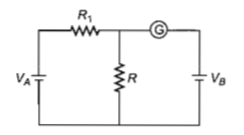The resistances in the two arms of the meter bridge are 5 and R , respectively. When the resistance R is shunted with an equal resistance, the new balance point is at 1.6. The resistance R, is

(1)10Ω
(2)15Ω
(3)20Ω
(4)25Ω

(1)10Ω
A potentiometer circuit has been setup for finding the internal resistance of a given cell. The main battery, used across the potentiometer wire, has an emf of 2.0 V and a negligible internal resistance. The potentiometer wire itself is 4 m long. When the resistance, R, connected across the given cell, has values of
(i)infinity
(ii)9.5Ω
the 'balancing lengths', on the potentiometer wire are found to be 3m and 2.85m, respectively. The value of internal resistance of the cell is
(1) 0.25Ω
(2) 0.95Ω
(3) 0.5Ω
(4) 0.75Ω
A wire of resistance 4Ω is stretched to twice its original length. The resistance of a stretched wire would be :
(1)2Ω
(2)4Ω
(3)8Ω
(4)16Ω
The internal resistance of a 2.1V cell which gives a current of 0.2A through a resistance of 10Ω is :
(1)0.2Ω
(2)0.5Ω
(3)0.8Ω
(4)1.0Ω
The resistances of the four arms P, Q,R and S in a Wheatstone's bridge are 10Ω ,30Ω ,30Ω and 90Ω, respectively. The emf and internal resistance of the cell are 7 V and 5 Ω respectively. If the galvanometer resistance is 50Ω, the current drawn from the cell will be
(1) 1.0A
(2) 0.2A
(3) 0.1A
(4) 2.0A
In the circuit shown the cells A and B have negligible resistances. For the galvanometer (g) shown no deflection.The value of is
(a)4V (b)2V
(c)12V (d)6V
If voltage across a bulb rated 220 V-100 W drops by 2.5% of its rated value, the percentage of the rated value by which the power would decrease is
(1)20%
(2)2.5%
(3)5%
(4)10%
A ring is made of a wire having a resistane
. Find the points A and B, as shown
in the figure, at which a current carrying
conductor should be connected so that the
resistance R of the sub circuit between these
points is equal to 8/3
1. 2.
3. 4.
The power dissipated in the circuit shown in
the figure is 30 Watt. The value of R is :
(1)
(2)
(3)
(4)
A cell having an emf internal resistance r is connected across a variable external resistance R. As the resistance R is increased, the plot of potential difference V across R is given by
(a) 
(b)
(c)
(d)








